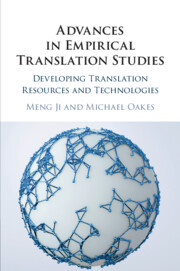Book contents
- Advances in Empirical Translation Studies
- Advances in Empirical Translation Studies
- Copyright page
- Contents
- Figures
- Tables
- Contributors
- Preface
- 1 Advances in Empirical Translation Studies
- 2 Development of Empirical Multilingual Analytical Instruments
- 3 Statistics for Corpus-Based and Corpus-Driven Approaches to Empirical Translation Studies
- 4 The Evolving Treatment of Semantics in Machine Translation
- 5 Translating and Disseminating World Health Organization Drinking-Water-Quality Guidelines in Japan
- 6 Developing Multilingual Automatic Semantic Annotation Systems
- 7 Leveraging Large Corpora for Translation Using Sketch Engine
- 8 Developing Computerised Health Translation Readability Evaluation Tools
- 9 Reordering Techniques in Japanese and English Machine Translation
- 10 Audiovisual Translation in Mercurial Mediascapes
- 11 Exploiting Data-Driven Hybrid Approaches to Translation in the EXPERT Project
- 12 Advances in Speech-to-Speech Translation Technologies
- 13 Challenges and Opportunities of Empirical Translation Studies
- Index
- References
11 - Exploiting Data-Driven Hybrid Approaches to Translation in the EXPERT Project
Published online by Cambridge University Press: 10 June 2019
- Advances in Empirical Translation Studies
- Advances in Empirical Translation Studies
- Copyright page
- Contents
- Figures
- Tables
- Contributors
- Preface
- 1 Advances in Empirical Translation Studies
- 2 Development of Empirical Multilingual Analytical Instruments
- 3 Statistics for Corpus-Based and Corpus-Driven Approaches to Empirical Translation Studies
- 4 The Evolving Treatment of Semantics in Machine Translation
- 5 Translating and Disseminating World Health Organization Drinking-Water-Quality Guidelines in Japan
- 6 Developing Multilingual Automatic Semantic Annotation Systems
- 7 Leveraging Large Corpora for Translation Using Sketch Engine
- 8 Developing Computerised Health Translation Readability Evaluation Tools
- 9 Reordering Techniques in Japanese and English Machine Translation
- 10 Audiovisual Translation in Mercurial Mediascapes
- 11 Exploiting Data-Driven Hybrid Approaches to Translation in the EXPERT Project
- 12 Advances in Speech-to-Speech Translation Technologies
- 13 Challenges and Opportunities of Empirical Translation Studies
- Index
- References
Summary
Technologies have transformed the way we work, and this is also applicable to the translation industry. In the past thirty to thirty-five years, professional translators have experienced an increased technification of their work. Barely thirty years ago, a professional translator would not have received a translation assignment attached to an e-mail or via an FTP and yet, for the younger generation of professional translators, receiving an assignment by electronic means is the only reality they know. In addition, as pointed out in several works such as Folaron (2010) and Kenny (2011), professional translators now have a myriad of tools available to use in the translation process.
- Type
- Chapter
- Information
- Advances in Empirical Translation StudiesDeveloping Translation Resources and Technologies, pp. 198 - 216Publisher: Cambridge University PressPrint publication year: 2019



